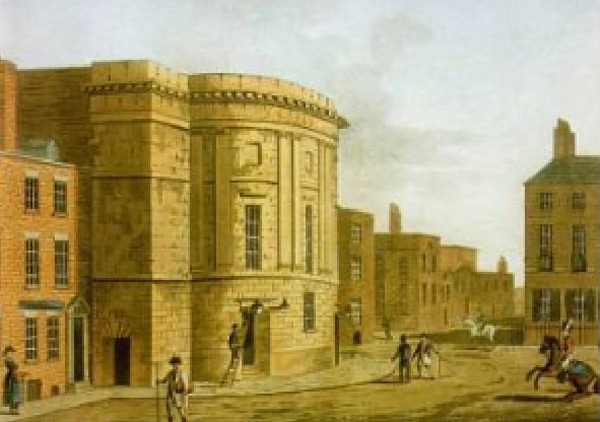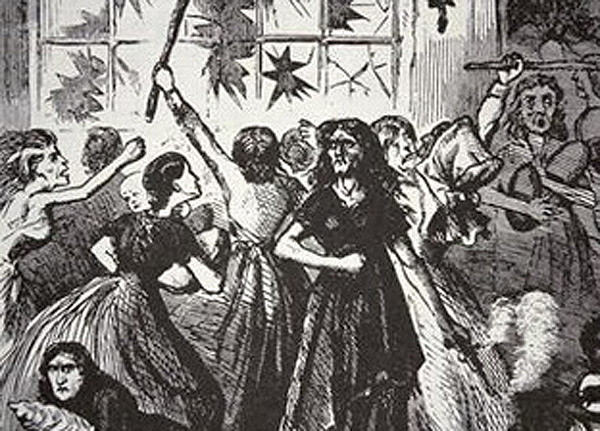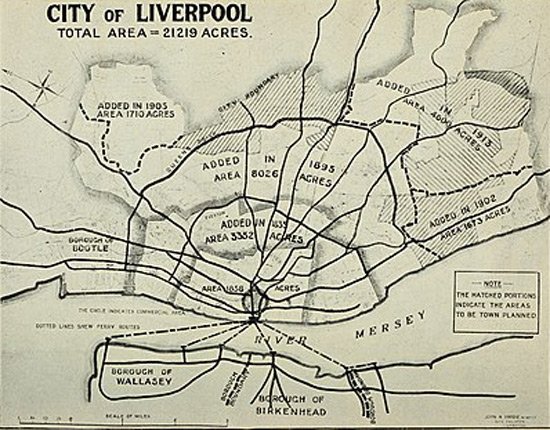The Missing History of Liverpool – Part 1
Liverpool’s Forgotten Riots
By Steve Moss
So you know all about the Liverpool riots of course? No, I’m not referring to the 1981 Toxteth Uprising. Nor the unrest in 2011. “The 1919 race riots, then?” Nope, not those. “Then I guess you’re talking about the 1911 Transport Strike”. No, not even the 1987 Beastie Boys riots. Actually, Liverpool has a long & proud, unknown history of unrest and generally kicking off at every opportunity.
Liverpool grew from a town of 7,000 people in 1700 to one of 77,000 by 1801 and this rapid expansion inevitably led to increased opportunities for conflict, and for people to find sufficient numbers of equally pissed-off brothers and sisters to join forces with. The earlier concentration of homes in the town had meant that rich and poor were living side-by-side and were subject to rules of maintaining the upkeep of the town, which provided some sense of commonality (bar the occasional episode of disharmony caused by the guy next door playing his lute at antisocial hours). The expansion during the 1700s led to a growing separation of classes. Duke and Rodney Street were built to provide an escape for those able to afford one of the elegant houses there, whilst the wealthiest moved further afield to greener areas. Meanwhile the poor were relocated into insanitary slum housing in the Vauxhall area, near the noisy docks.
In 1810 disturbances broke out at the Theatre Royal for two weeks. This followed riots at a London theatre, triggered by an increase in ticket prices and other alterations that were interpreted as a realignment of social relations. However, the local actions were based on demands for a half-price entry mid-way through the evening’s entertainment, as was common in London. Placards bearing the initials H.P. appeared in the auditorium and there were even attempts to perform the H.P. dance, although no descriptions remain as to what the dance looked like. The performances were interrupted ‘by using flappers, horns, whistles, and other cacophonous instruments’, with the rioters going on to smash all the theatre’s windows. Newspaper reports noted how ‘not a syllable of the performance could reach the ears of the audience’ and ‘several things were flung on the stage’.
Amongst those imprisoned were a merchant’s clerk ‘who brought three whistles, and after distributing them to as many persons in the pit, gave his pupils a lesson on the instrument’, and a book-keeper charged with ‘groaning, hissing, whistling, catcalls, and making other noises to disturb the performances’ and distributing protest songs. These protests were swiftly ended as the group didn’t have the support of the larger population of Liverpool. Nevertheless, the auditorium had become a political and social forum in which those who could not vote could make their opinions known.
A further disturbance occurred in 1824 when a popular singer named Mary Cramer was replaced by a substitute for breaking the terms of her contract. The audience in the gallery showered oranges and apples down onto the stage, along with the iron rail, destroying all the foot-lamps, whilst pulling up the seats and throwing them at the chandelier. Having run out of missiles, they then pulled the plaster off the walls of the gallery and threw it at the performers on stage. Two evenings later, several benches were thrown from the gallery and five men taken into custody.
 The Theatre Royal, early 1800’s
The Theatre Royal, early 1800’s
The first in a proud history of Tories being chased out of Liverpool occurred during the election of 1826 when anyone supporting William Huskisson MP or wearing red was attacked, followed five years later by a memorable occasion when a parade was attacked and ‘a shocking bad hat was played shuttlecock with for some time, when flung at Lord Sandon; but his Lordship, by a dexterous use of his arm, saved his person from contact with so filthy a missile. In Lord Street a stone was aimed at him; in Duke Street a piece of the bottom of a bottle was near hitting him; and soon after…a dead cat was flung with too accurate an aim’.
During the election of 1837, Tories were driven out of Castle Street, before they ripped up opponents’ banners and tried to retake their lost ground. Ships carpenters attacked everyone wearing conservative colours, while Tory mobs in Toxteth Park (I know, unthinkable today!) caused mayhem – ‘many persons who wore the opposite colours were assailed by women of the lowest order, and compelled to remove them’. Over 1000 Irish armed with staves attacked police on Park Lane, severely injuring seven of them, while 500 men overpowered police at Moorfields.
Another election in 1841 led to vicious fighting between political parties. A party of ships carpenters listening to speeches in Rodney St were attacked by 600 Irishmen. 130 police arrived to separate the two and were attacked by both sides for two hours. Many amongst the crowd of 2,000 climbed on roofs to pelt the police below with slates, bricks, and chimney pots, killing a Conservative flagbearer, whilst a 17-year-old Irish woman was shot & killed by a publican when a mob attacked his pub. The offices of the rival newspapers Liverpool Mercury and Liverpool Standard were attacked, as were many shops. A great deal of the violence was directed solely at the police, and there were 175 arrests. Special constables who had been appointed during the election attracted so many complaints about their undisciplined behaviour that the police chief locked them all up in St John’s Market and continued the battle without them!
A Whig meeting on Upper Pitt St in 1837 led to disorder when the speakers made promises of cheap bread and sugar but ‘an unfortunate minority…were not inclined to swallow all the cheap electioneering eloquence of Mr Ewart and his friend Mr Elphinstone, seeing that the deeds of the former, when in Parliament, did not keep pace with the promises out of it, and accordingly they ventured to express their doubts by exclamations of “Gammon”’. When questions were raised on the subject of bribery there was uproar – ‘the eloquence of the candidates was suddenly hushed, giving place to the hollow sounds caused by the sticks falling heavily on the heads of the contending parties’. The police attempted to intervene but were persuaded that the Whigs were strong enough to beat up anyone who didn’t share their views and left them to it.
The Bread Riot of 1855 was instigated by the freezing over of the Mersey, bringing the docks to a standstill and putting thousands out of work, leading to mass destitution in unbearably low temperatures. The relief on offer was overwhelmed and awarded arbitrarily to those deemed deserving – tickets for bread provisions were given away freely but, as people became more desperate, the biggest men went scrapping for the greatest share, leaving others to go hungry. After three older women were crushed in a crowd of over a thousand people, fighting for a morsel of food, large numbers began raiding bakeries and bread shops.
This unrest spread to half of Liverpool – some shops were totally stripped and bread carried away in carts. They would also help themselves to bags of flour, the Liverpool Mercury reporting that at one bakery ‘the rabble appeared to relish this adventure…and continued to pelt each other with dough for nearly half an hour’. The gates of St John’s Market were closed to stop rioters entering, while omnibuses were also stopped and the conductors robbed. ‘The mob, to the number of 1,000, replied to the premises of Mr Robinson, an eating-house keeper…whilst several parties were at dinner…they deliberately took away from the table the very dinner of which the visitors were in the act of partaking’.
Meanwhile ‘in one baker’s shop a woman stole several pounds of peameal, thinking it was flour, and when she was informed by some of her companions of her mistake, she cooly returned to the scene of her depredation, and indignantly demanded that it should be changed for flour. The shopman, of course, refused to comply with her demand, but he did not then dare to take from her the property she had appropriated and with which she was amusingly dissatisfied’.
The police were stoned and many prisoners rescued, however over 100 were detained and given harsh sentences. There was great anxiety on the part of the authorities to deny that rioters had any reason to steal bread and the trouble was blamed on ‘disorderly men and women, not the suffering & deserving poor’ and ‘youths of the lowest class, and rough-looking men, whose appearance indicated a desire for mischief and riot, rather than the desperation caused by hunger…’. Particular blame was placed on the Irish – ‘one of those disgraceful riots emanating from the lower orders of Roman Catholics’. The Liverpool Mail commented: ‘If Irish paupers are to be absolutely irremovable by law – all property in Liverpool must gradually deteriorate in value… for Irish poverty of the lowest grade seems inseparable from habitual criminality.’ This Tory newspaper typified the view of many people in Liverpool.
In fact, the majority of those arrested and brought to court actually had no previous convictions but were made an example of nevertheless, typically 3 months hard labour for being found in a shop, despite their protestations that they thought relief was being given out, or being caught in possession of 4 loaves.
The closing of the Liverpool Exhibition at Wavertree Botanic Gardens in 1886 provided another excuse for a kick-off. ‘A gang of noisy young men…swarmed into the principal refreshment rooms, before closing time, and refused to leave…One policeman who was on the premises was rolled in the sawdust, and the…principal persons engaged in resisting the closing of the establishment pretty well saturated him with liquor from their glasses’. They were forced outside and the doors closed but they broke back inside. ‘The police then…drew their batons and dealt many of the young men some serious blows. The police got mixed up in the crowd, and thereby some of them were somewhat roughly handled.’ More police eventually arrived and drove them into Edge Lane.
These are just a handful of the recorded riots in our city. And I’ve not even started on all the Birkenhead ones. In my next article, I will provide an update on all the riots that have taken place since writing this. So people, go to it!
Read more:
- John Belchem (ed.), Popular Politics, Riot and Labour: Essays in Liverpool History 1790-1940, Liverpool University Press (1992)
- https://liverpoolanarchist.wordpress.com/2022/02/11/the-liverpool-bread-riot-of-1855/
- This is the full length version of an article in the latest edition of Liverpool’s ‘magazine of creative anarchy’ Banned In Braille. The winter ’23-’24 edition is in News From Nowhere Bookshop.


Permalink
Very well written article. Lots of information and in a very accessible style ie easy to follow and exciting. Thank you for this